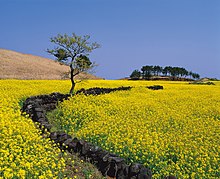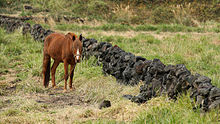Jeju-do stone walls
The stone walls of Jeju-do are walls made of pumice stone , which the inhabitants of the island Jejudo ( 제주도 ) in the south of South Korea built for different purposes and which today have a cultural and historical significance.
history
It is believed that tribes who had developed field cultivation methods came to Jejudo Island and took control of the Tamna Empire ( 탐나 ) there. The point in time when that should have happened is still in the dark. Tamna was annexed in 1105 by the Goryeo empire ( 고려 ), to which it was previously tributary. A high administrative official from this time has handed down that the stone walls of Jejudo were originally built as border markings, since the influential and powerful of the island repeatedly absorbed land from the poor rural population. After Gim Gu ( 김구 ) (1211–1278), who was described as this official and who, after his inauguration, learned of the needs of the peasants and had the walls built, the border disputes decreased. With the expansion of agriculture to the slopes of the Hallasan volcano ( 한라산 ), which is located in the center of the island, the demands on agriculture also increased, as the slopes above were poorer soil. The fencing of the arable land increasingly had the advantage that the soil was protected from erosion by wind and weather and thus fertile soil could develop over the years even in the higher elevations.
In 1270, military units of the Goryeo government, which had surrendered to the invading Mongols years earlier, began to build coastal fortification walls on Jejudo against Goryeo's elite units Sambyeolcho ( 삼별초 ), who refused to surrender to the Mongols. The long-standing walls, which functioned as breakwaters and anchorages , were connected. They should prevent or make landings on the coast more difficult. During this time, walls between the fields were strengthened for defense purposes. When the Sambyeolcho were defeated and the Mongols brought the rearing of horses to the island, stone walls between 1.2 and 1.5 m high, called Jat ( 잩 ) or Jat-seong ( 잩성 ) , were built in higher elevations . These walls delimited the horse breeding areas and thus protected agriculture from damage by grazing animals.
Types of stone walls
There are essentially three different types of stone walls on the island, which are named differently depending on their purpose and meaning.
Batdam
The most famous and most common stone walls are the walls called Batdam ( 밭담 ), where bat can be translated as "field" and dam as "enclosure". They played an important role in the development of agriculture on the island and have emerged over the past 1000 years. The Batdam cover the island like a spider's web from the hills to the coast and extend over a total of 22,100 km. They not only increase the scenic charm of the island, but are also recognized as the island's most important cultural heritage in addition to their functional value for agriculture.
Wondam
The Wondam ( 원담 ) or Gaetdam ( 갵담 ) called walls are up to one meter high walls built on the flat parts of the coast in the sea. As so-called stone weirs, they are used for fishing. The fish that come to the coast at high tide get caught in the crevices when the tide starts and the water escapes through the crevices. The stone weirs are the property of the respective villages on whose coast they were built. August is a special fishing season when schools of 10 to 20 cm long anchovies , in Jeju dialect Mel ( 멜 ), but in Korean called Myeol-chi-gwa ( 멸치과 ), get caught in stone weirs and with nets and ladles are caught by the villagers. The catches are shared fairly among the villagers.
Sandam
Sandam ( 산담 ) ( san = mountain), on the other hand, are walls that were used to enclose graves. They should protect the graves from fire and from destruction by animals grazing in the area. But these walls also differ in their shape and the way they are built. As Oedam ( 외담 have) refers to masonry, the coated in a series of basalt rocks and mostly in the circle, quadrangle or acorn shape are designed and Gyeopdam ( 겹담 ) always consists of a double row masonry, in which the intermediate spaces are filled with smaller rocks and the arrangement of the masonry has a trapezoidal shape, on the short side of which the grave is located.
Every fence has a gate through which, it is believed, the souls of the deceased can pass. If the gate is on the left side of the enclosure, a male person was buried there, whereas if the gate is on the right side, the grave belonged to a female person. The gates consist of a 40 to 50 cm wide passage that was covered with oblong stones so that cattle grazing in the area could not gain access to the tomb.
literature
- Lee Chang-guy: The Historical Legacy of the Stone Walls of Jeju-do . In: Koreana . Volume 13, No. 2. The Korea Foundation , 2018, ISSN 1975-0617 , p. 4–11 (German-language edition).
- Kim Yu-jeong: Guardian on the border with the afterlife . In: Koreana . Volume 13, No. 2. The Korea Foundation , 2018, ISSN 1975-0617 , p. 22-25 (German-language edition).
- Minjungs Korean-German Dictionary . Korean Society for German Studies, Seoul 1981, ISBN 978-89-387-0502-0 (Korean).
- Jeju Batdam Agricultural System . Jeju Special Self-Governing Province , December 2013 (English, Online [PDF; 5.6 MB ; accessed on November 2, 2018]).
Web links
- Yoon Sojung: FAO recognizes traditional agricultural methods . In: Korea.net . Department Global Communication and Contents Division , April 22, 2014, accessed November 2, 2018 .
Individual evidence
- ↑ Lee: The Historical Legacy of Jeju-do Stone Walls . In: Koreana . 2018, p. 10 .
- ↑ Lee: The Historical Legacy of Jeju-do Stone Walls . In: Koreana . 2018, p. 7th f .
- ↑ Lee: The Historical Legacy of Jeju-do Stone Walls . In: Koreana . 2018, p. 10 f .
- ↑ Minjungs Korean-German Dictionary . 1981, p. 958, 431 .
- ↑ Lee: The Historical Legacy of Jeju-do Stone Walls . In: Koreana . 2018, p. 9 .
- ↑ Lee: The Historical Legacy of Jeju-do Stone Walls . In: Koreana . 2018, p. 6th f .
- ↑ Minjungs Korean-German Dictionary . 1981, p. 792 .
- ↑ Kim: Guardian at the border to the afterlife . In: Koreana . 2018, p. 22, 24 .
- ↑ Kim: Guardian at the border to the afterlife . In: Koreana . 2018, p. 24 .

